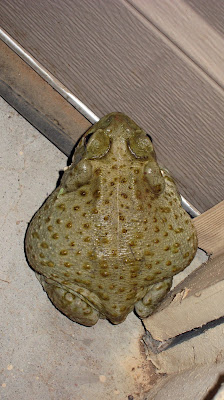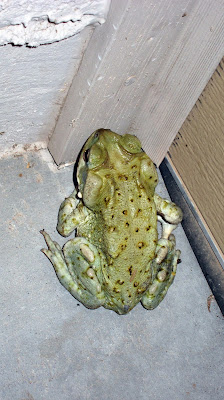On warm summer nights, some central Arizona neighborhoods are visited by these princes (and princesses) in disguise, Sonoran Desert Toads (Incilius alvarius). The New River corridor is a popular stretch of habitat for these wide-mouthed, warty amphibians. Although the adults are terrestrial, and content to spend most of the year in burrows that may be miles from any water, permanent or temporary ponds are necessary for reproduction.
They will take advantage of nearly any water source we provide for them, intentionally or unintentionally, to re-hydrate. Dog dishes, bird baths and shallow steps of swimming pools are perfect places to sit for a while and fatten up after a long winter below ground. Toads imbibe water through their skin, especially through a special "drinking patch" on their belly and hind legs. A few hours sitting in a mud puddle can make the difference between a "full" toad and a skinny toad. Although many folks regard them as pests, because they are also quite toxic, especially to dogs that harass them, having a few toads around can serve as effective pest management, since they will eat huge quantities of insects.
Toad scat is dry and ashy, essentially the keratinous remains of the insects they have eaten. This large sample of toad scat is compared to my ring; it's as thick as my finger, but not gooey at all. If you step on it, the turd turns to dust and blows away on the wind. Just another fun little nature tidbit for you!













